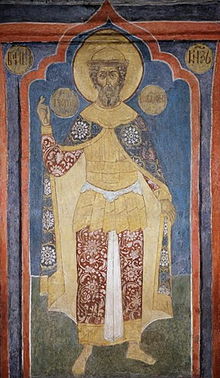Our website is made possible by displaying online advertisements to our visitors.
Please consider supporting us by disabling your ad blocker.
Yuri II of Vladimir
This article has multiple issues. Please help improve it or discuss these issues on the talk page. (Learn how and when to remove these messages)
|
| Yuri II of Vladimir | |
|---|---|
| Grand Prince of Vladimir | |
 | |
| Reign | 1212–1216, 1218–1238 |
| Predecessor | Vsevolod the Big Nest |
| Born | 26 November 1188 |
| Died | 4 March 1238 Battle of the Sit River |
| Spouse | Agatha (daughter of Vsevolod IV of Kiev) |
| Issue | Vsevolod Vladimir |
| House | Yurievichi |
| Father | Vsevolod the Big Nest |
| Mother | Maria Shvarnovna |
Yuri II (Russian: Ю́рий–II, also transcribed as Iuri[1]), also known as George II of Vladimir or as Georgy II Vsevolodovich (26 November 1188 – 4 March 1238), was the fourth Grand Prince of Vladimir (1212–1216, 1218–1238) who presided over the Principality of Vladimir-Suzdal at the time of the Mongol invasion of Kievan Rus'.[citation needed]
He was the seventh child and the third and best-loved son of Vsevolod III (Vsevolod the Big Nest) and of Maria Shvarnovna.[citation needed]
He first distinguished himself in the battles against Ryazan in 1208. His father wanted Yuri to inherit Rostov and his elder brother Konstantin to succeed him in Vladimir. The latter, however, declared that he would rule both towns or nothing at all.[citation needed] Thereupon Vsevolod disinherited Konstantin[citation needed] and passed the throne to Yuri, who received the largest portion of his possessions.[1]
Before his death, grand prince Vsevolod divided his territories between his sons; as soon as he died in 1212, the Vladimir-Suzdal war of succession (1212–1216) broke out between them.[1] Konstantin allied himself with Mstislav the Bold and defeated Yuri and his other brothers on the Lipitsa River.[citation needed] Having gained Vladimir, Konstantin sent Yuri to rule Rostov and Yaroslavl. Two years later Konstantin died, and Yuri was allowed to return to Vladimir.[citation needed]
During his reign in Vladimir, Yuri waged several wars against Volga Bulgaria and founded the fortress of Nizhny Novgorod on the Volga River to secure the area from Bulgarian attacks. He installed his younger brother Yaroslav in Novgorod. When the Mongols first approached Russia in 1223, he sent a small unit against them, but it arrived too late to take part in the disastrous Battle of the Kalka River in May 1223.[citation needed]
When the Mongols returned in 1237, Yuri treated their envoys with disdain. Likewise, he did not help Ryazan when Batu Khan laid siege to that city in December 1237. His own capital, however, was the next in line. Yuri's sons were soundly defeated near Kolomna, and Yuri himself could barely escape to Yaroslavl. His wife Agatha (Mikhail of Kiev's sister) and all his family died in Vladimir when the Assumption Cathedral where they had sought refuge from the fire collapsed in February 1238.[citation needed] Russian historians (Vadim Kargalov, Gelian Prokhorov) believe that this information was deliberately falsified. The purpose was to hide the fact that some members of the princely family were captured. The most likely was the capture of Agatha, her daughter Princess Theodora, or the young Princess Marina, the wife of Yuri's son Vsevolod Yur'evich. (Princess Marina was not canonized in the Cathedral of the Vladimir Saints together with the rest of the Vladimir Martyrs who died in the Assumption Cathedral).[2]
Yuri himself was killed on 4 March 1238, in the Battle of the Sit River, when vast Mongol hordes defeated the army of Vladimir-Suzdal. The relics of the prince are in the Dormition Cathedral, Vladimir.[citation needed]
- ^ a b c Alef, Gustave (1956). A history of the Muscovite civil war: the reign of Vasili II (1425–1462) (PhD). p. 11. Retrieved 7 May 2023 – via ProQuest.
When Vsevold died in 1212 he divided his territories among his sons, the largest portion going to the second oldest, Iuri. Immediately the sons began to war amongst themselves, each striving to achieve a more favorable position and lands which contributed to the decline of the Suzdal-Vladimir principality.
- ^ Прохоров Г. М. Повесть о Батыевом нашествии в Лаврентьевской летописи // Труды отдела древнерусской литературы. — Л., 1974. — Т. 28. — С. 77—98.
Previous Page Next Page


